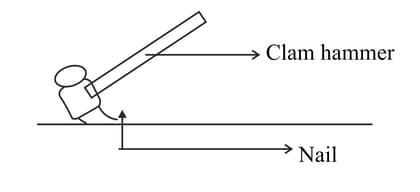The slope of an inclined plane is the tangent of the angle made by _____.
Important Questions on Force and Laws Of Motion
Find the retardation with which a train moving at is brought to rest in seconds.
The diagram below shows a pulley arrangement:

Copy the diagram and mark the direction of tension on each stand of the string.
What is the velocity ratio of the arrangement?
If the tension acting on the string is, then what is the relationship between and effort ?
If the free end of the string moves through a distance , find the distance by which the load is raised.
The diagram below shows a claw hammer used to remove a nail:

(i) To which class of lever does it belong?
(ii) Give one more example of the same class of lever mentioned by you in (i) for which the mechanical advantage is greater than one.
Define Newton's first law and Inertia.
When an object falls freely to the ground, its acceleration is uniform.
Give scientific reasons.
Even though the magnitude of action force and reaction force are equal and their directions are opposite, their effects do not get cancelled.
A body moves with constant velocity of . The mass of body is . The unbalanced force acting on the body is _____ .
Describe Galileo's experiment. What was the result of this experiment ?

